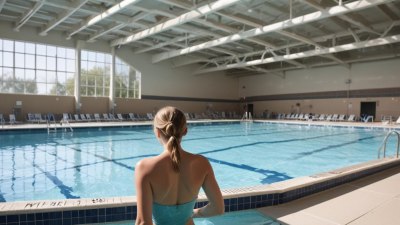Why Public Pool Water Always Smells Like a Chemistry Experiment Gone Wrong
Discover the science behind the distinct smell of public pool water and what it means for water quality.

This image was created with the assistance of Freepik
When you step into a public swimming pool, you might be greeted by a familiar yet unpleasant smell that often resembles a chemistry experiment gone wrong. This odor isn’t just a random byproduct of chlorination; instead, it's a complex interplay of chemicals, biological contaminants, and maintenance protocols. In this article, we’ll dive deep into why public pool water has a distinctive smell, what causes it, and how pool managers address these issues to ensure safe swimming environments.
The Role of Chlorine in Pool Maintenance
Chlorine is one of the most commonly used disinfectants in public pools. It serves a critical function by killing bacteria and other harmful pathogens that could pose health risks to swimmers. However, chlorine doesn’t only act as a disinfectant; it also reacts with organic matter, such as sweat, urine, and other contaminants introduced by swimmers. This reaction leads to the formation of chloramines, chemical compounds that often create the infamous chlorine smell associated with public pools.
Understanding Chloramines
Chloramines are formed when chlorine reacts with nitrogen-containing compounds found in sweat, urine, and skin cells. This process not only diminishes the effectiveness of chlorine as a sanitizer but also contributes to the unpleasant odor. There are three main types of chloramines produced: monochloramine, dichloramine, and trichloramine, each varying in potency and smell. Dichloramine, in particular, is known for its strong, pungent aroma, commonly mistaken as the smell of chlorine itself.
Sources of Organic Contaminants
The presence of organic matter is a major contributor to chloramine formation in pool water. Swimmers unintentionally bring in contaminants, and even the most diligent hygiene practices may not eliminate all forms of organic material. Sweat and skin oils are among the largest contributors. Studies indicate that a single swimmer can leave behind up to 0.5 grams of organic material during a swim, which can lead to significant problems if not properly managed.
Water Chemistry and Pool Maintenance
Regular water testing is crucial for maintaining proper chemical balances in pool water. Pool operators regularly check levels of chlorine, pH, and total alkalinity to ensure water is safe and comfortable for users. An unbalanced pH can exacerbate the development of chloramines, leading to a more pungent smell. Ideally, pools should maintain a pH between 7.2 and 7.8 for optimal chlorine effectiveness.
Impact of Environmental Factors
The chemical composition of pool water can also be affected by external environmental factors such as humidity, temperature, and sunlight. Higher temperatures can increase the breakdown of chlorine, prompting more chloramine formation to counterbalance the loss of disinfectants in the water. Additionally, excessive heat can make people sweat more, contributing to increased levels of organic material introduced into the pool.
Pool Design and Filtration Systems
Modern public pools are generally equipped with sophisticated filtration systems designed to remove impurities and keep chloramines in check. However, these systems must be adequately maintained to function correctly. A poorly maintained filtration system can lead to the accumulation of contaminants and stagnant water, which results in a more pronounced chemical smell. Regular backwashing, cleaning of filters, and appropriate water turnover rates are essential components of effective pool maintenance.
Ventilation Matters
In many indoor pools, inadequate ventilation can also contribute to the lingering smell of chloramines. Proper air circulation helps dissipate any odors and reduces indoor air quality issues. Operators often use a combination of dehumidification and fresh air systems to combat this issue. Without sufficient ventilation, chloramines can accumulate in the air, leading to respiratory discomfort for swimmers and lifeguards alike.
Addressing the Odor Issue
Public pool managers are constantly seeking ways to mitigate the chemical smell. One approach involves increasing the frequency of water testing and adjusting chemical levels more precisely. Additionally, shock treatments, or superchlorination, can be employed to break down chloramines and restore a balance to the pool water. However, this process must be timed carefully to minimize discomfort for swimmers.
The Importance of Education
Educating the public on pool etiquette is another strategy that can help reduce the introduction of contaminants. Swimwear hygiene, the importance of using showers before entering the pool, and avoiding urination in the water are crucial aspects that all swimmers ought to understand. Facilities often implement strict rules and provide reminders to promote better practices among patrons.
Alternative Sanitation Methods
Some pools have begun exploring alternative sanitation methods to reduce reliance on traditional chlorine. Options like saltwater systems, ozone generators, and ultraviolet (UV) light systems are gaining popularity because they can reduce the formation of chloramines and improve overall water quality. For example, while saltwater systems still use chlorine, they generate it naturally through the electrolysis of salt, leading to lower levels of chloramines and a gentler swimming experience.
A Balancing Act
In conclusion, the distinct smell of public pool water is a result of a complicated interplay between chlorination, organic contaminants, water chemistry, and environmental factors. Understanding these dynamics can help swimmers appreciate the complexity of maintaining safe and pleasant aquatic environments. While the ‘chemistry experiment’ smell may never entirely disappear, ongoing efforts by pool operators and educating the public can significantly improve the experience for all. The next time you notice that chlorine smell, you'll be equipped with knowledge about its origins and how it reflects the efforts made to ensure your health and safety at the pool.











